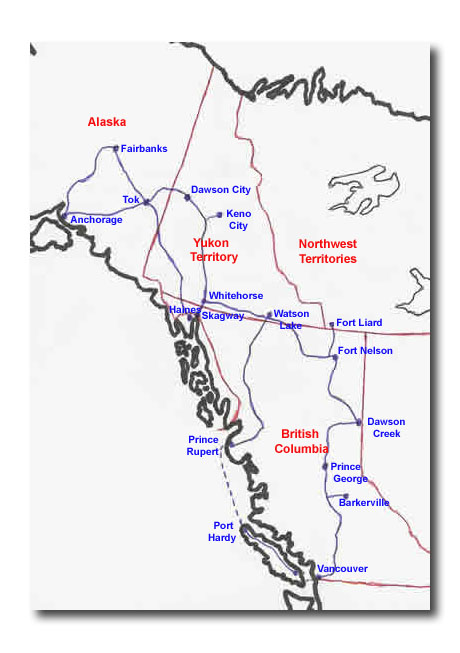|
Sunday, July 18 - Watson Lake to Whitehorse Our day started with Mass at St Ann’s Mission in Watson Lake. It was a small church, seating 60, maybe half full. I thought what a shame it was that of all the thousands traveling through here each day, such a small number would have a faith strong enough to spend an hour in church. After Mass, we made our pilgrimage to Watson Lake’s famous Signpost Forest. Started in 1942 during the construction of the Alaska Highway when a lonely serviceman nailed a sign of his hometown to a tree, it now hosts close to 60,000 signs, with about 2,000 added each year. Instead of trees, posts are planted in the ground and tourists nail their signs to them. It was really neat to walk through, seeing all manner of signs from all over the world. Christopher had made a sign before we left, and we added it to the collection. The entire length of the 1,500 mile highway from Dawson Creek to Delta Junction near Fairbanks, was built in just 8 months by 10,000 men as part of the war effort. The section of the Alaska Highway from Watson Lake to Whitehorse, especially after the grueling drive up the Cassiar Highway, was a treat to drive. It is a wide, two-lane undivided highway with paved shoulders. It was really surprising to experience such a big sky, with low distant horizons in every direction, again so much different than the Cassiar Highway which hugs the feet of the mountains the whole way. The drive follows the shoreline of many beautiful lakes, with gorgeous displays of fireweed lining much of the way. The boys couldn’t resist the urge to stop for lunch at Wolf It Down Restaurant, obviously one of the more notable establishments in the Yukon. With a name like that, I was more concerned about wolfing it up than wolfing it down, but soon came to realize that the name was apt, not because of the quality of the food but rather the quantity – the portions were very small and disappeared quickly. The weather was sunny and hot, the temperature about 34 degrees Celsius. Along one stretch we saw wisps of smoke coming from about half a dozen small forest fires on hillsides a few miles distant. Another initiative started by a swim team a few years ago was the making of stone lettering alongside the highway. The boys joined hundred of others in leaving their stone legacy. Whether it be chain saw carving, or more refined and detailed hand carving, you can’t miss seeing lots of wood carving wherever you stop. As we were driving along at about 8:30pm, the sun was still at a 45 degree angle in the sky. We arrived in Whitehorse about an hour later at the home of our friends Sue Johnson and Larry DuGuay. Sue’s family is lifelong friends of Anne’s family; Anne babysat Sue 40 years ago! Sue is a physiotherapist and Larry a potter. We sat up and talked until after 11:30pm without the lights on – it was still light enough outside. At 12:30 it was twilight! Watson Lake to Whitehorse photos, click here. Monday, July 19 - WhitehorseWhat a treat not to have to drive today! And to be able to sleep in! Sue and Larry’s place in about 10km from the city centre. We drove into the city in the early afternoon to see the McBride Museum and the S.S. Klondike. Exhibits in the McBride Museum included a really neat collection of gold nuggets, with displays about the progression of different mining methods during the Gold Rush, as well as an opportunity to try your hand at gold panning. David and Geoffrey had a go at it. Although they didn’t know it until after, each pan is seeded with 6 tiny gold nuggets. David got all six, while Geoffrey got five. Also at the McBride Museum is Sam McGee’s cabin. He was immortalized in the Robert Service poem, The Cremation of Sam McGee, which was featured in a live performance on the doorstep of the cabin. The S.S. Klondike is a sternwheeler that could carry over 300 tons of mail, supplies, passengers and ore, traveling between Dawson City and Whitehorse from 1929 until her retirement in 1955. Now, completely refurbished, it’s a National Historic Site, with guided tours. Amazingly, this 240 foot long boat only draws 26” of water empty, and 40” when fully loaded. As an appetizer for dinner tonight, Larry barbequed moose sausage. I expected it to taste really gamey, but was completely surprised to find it no stronger than domestic meats. We’ll do more things in Whitehorse when we return in three weeks. Whitehorse photos, click here. |

Watson Lake to Whitehorse
From Watson Lake to Whitehorse. Scroll down to read our Journal.
Watson Lake to Whitehorse photos, click here.
Whitehorse photos, click here.